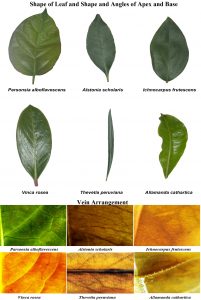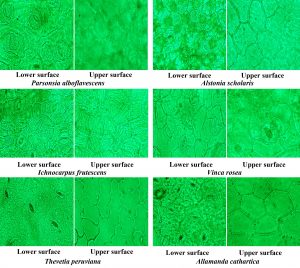*Dr. Prashant Kumar Jha, Head, Quality Control Laboratories, ALNRMAMC, Koppa
Professor (Dr.) Sanjaya K.S., Principal, ALNRMAMC, Koppa
*Corresponding Author: [email protected]
Received on: 12-11-2022 Accepted: 15-12-2022 Corrected: 30-12-2022
Abstract: Background: Apocyanaceae is one important families with number of medicinal plants. It comprises of 5,500 species worldwide and 118 species in India. Taxonomical identification of these species is important. Characteristics of flowers and fruits are usually taken in consideration. However, morphometrics of leaves are given so importance. So, in present study six species of Apocyanceae family studied based leaf-characteristics.
Materials and Methods: Leaves of Parsonsia alboflavescens (Dennst.) Mabb., Alstonia scholaris (Linn.) R. Brown., Ichnocarpus frutescens (Linn.) W.T. Alton, Vinca rosea L., Thevetia peruviana (Pers.) Schum. and Allamanda cathartica Linn. were taken for the study. Leaf attachment, leaf organization, laminar shape, margin type apex shape, base shape, lobation, petiolar attachment and petiole features were evaluated based on observation. Surface preparation for individual leaf was done to observe distinction among stomata of undertaken species.
Result: Parsonsia alboflavescens exhibited ovate-oblong to oblong-lanceolate leaves with acute to acuminate apex and rounded to cordate base. The vein order was measured up to 5° with strong intersecondaries. The vein order of Thevetia and Allmanda were noted up to 3°. The anisocytic to anomocytic stomata were present only dorsal surface of the leaves.
Discussion and Conclusion: The laminar size of all undertaken species were different. Except three species with opposite leaf-arrangement, Allamanda and Alstonia were having leaves arranged in whorls whereas Thevetia was having crowded or alternate arrangement. Only Vinca rosea was observed with stomata on both surfaces.
Keywords: Apocyanaceae, Parsonsia, Alstonia, Ichnocarpus, Vinca, Thevetia, Allamanda, Leaf morphology …..
Apocynaceae is one of the ten most diverse families of flowering plants, comprising of around 5,500 species from 378 genera1. Botanical Survey of India in 30th volume of Fascicles of Flora of India mentions 118 species from 48 genera present in India. These species are herbs, shrubs, trees and vines. Intergeneric and interspecific taxonomical differences are based on nature of plants. Leaf morphology is one important characteristics along with differences of habit and flowers in plant systematics3. Variations in leaves are usually dealt using traditional morphomterics. Foliar morphometric is important in terms of geographical variations, but the shape of leaf for individual species doesn’t change5.
Leaf attachment, its organization, size of lamina, petiolar attachment, its size, laminar symmetry are important structural differences observed in between families, genera and species at places. Diversified venation architecture is observed across species. The first-order veins run from the base of leaf to the apex and, further according to branching only second-order and their-order veins are suggested. They are based on gene expression during the development of leaves6. They become important to differentiate genera and species too as genetic and morphometric complementary tool for phenotypic (morphological) differences7,8. Stomata are important structure present with every leaf. Their shapes vary between species and within species, so stomata are key structure for taxonomical identification9.
The objectives of present study were to: 1. Evaluate the taxonomic and diagnostic morphological features of leaves of six plants from Apocyanaceae. 2. To evaluate the stomatal differences using light microscopy for leaves of six plants of Apocyanaceae.
2. Materials and Methods
2.1. Collection and Identification of Plants
2.2. Measurement of taxonomic and diagnostic morphological features of leaves of six plants: Leaf attachment, leaf organization, laminar shape, margin type apex shape, base shape, lobation, petiolar attachment and petiole features were evaluated based on observation while size of lamina, margin type and petiole was measured using scale. The angles for base and apex were measured using arc. The various orders of veins were observed using 4x objectives. Clearing leaves were done using 5% solution of sodium hydroxide at 40-54°C for one week.
2.3. Surface preparation of leaves of six plants to find out the types of stomata: The leaf surfaces (both dorsal and ventral) were peeled off to observe the stomata under high power of fluorescence microscope from Dewinter.
3. Result
3.1.: : The six plants (Parsonsia alboflavescens (Dennst.) Mabb.; Alstonia scholaris (Linn.) R. Brown.; Ichnocarpus frutescens (Linn.) W.T. Alton; Vinca rosea L.; Thevetia peruviana (Pers.) Schum.; Allamanda cathartica Linn.) from Apocynaceae family were collected from the herbal garden of A.L.N. Rao Memorial Ayurvedic Medical College (ALNRMAMC). They were identified taxonomically based on morphological characters and flowering characteristics in Quality Control Lab, ALNRMAMC.
3.2.1:Leaf-related Characteristics (Figure No.: 1)
Parsonsia alboflavescens Alstonia scholaris Ichnocarpus frutescens
Leaf attachment Opposite In whorl of 4-7 Opposite
Leaf organization Single lamina Single lamina Single lamina
Petiole features Thickens at the base Thickens at the base Thickens at the base
Petiole size 2-4 cm 0.5-1.2 cm 0.4-0.7 cm
Position of petiolar attachment Marginal Marginal Marginal
Laminar size 12-18 cm x 4-9 cm 9-20 cm x 2-5 cm 5-7.5 cm x 2-4 cm
Laminar shape Ovate-oblong to oblong-lanceolate Elliptic-oblong to obovate Elliptic-oblong to oblong-lanceolate
Laminar symmetry Symmetrical Symmetrical Symmetrical
Base angle Greater than 180° Less than 90° Less than 90°
Base shape Rounded in young and cordate in matured Cuneate Acute
Apex shape Acute to acuminate Obtuse or rounded Acute
Apex angle Less than 90° In between 90° and 180° Less than 90°
Margin type Entire Entire Entire
Laminar length and width ratio 1.5-2.0 3.0-4.0 1.8-2.1
Lobation Unlobed Unlobed Unlobed
Vinca rosea Thevetia peruviana Allamanda cathartica
Leaf attachment Opposite Alternate, crowded Opposite
Leaf organization Single lamina Single lamina Single lamina
Petiole features Thickens at the base Thickens at the base Thickens at the base
Petiole size 2-4 cm 0.4-0.6 cm 0.4-0.7 cm
Position of petiolar attachment Marginal Marginal Marginal
Laminar size 2.5-6.5 cm x 0.7-2 cm 7.5-15 cm x 0.7-1 cm 6-10 cm x 3-4 cm
Laminar shape Oblong-lanceolate Linear-lanceolate Oblong to oblanceolate
Laminar symmetry Symmetrical Symmetrical Symmetrical
Base angle Less than 90° Less than 90° Less than 90°
Base shape Cuneate Cuneate Acute
Apex shape Acute Acute Acute
Apex angle Less than 90° Less than 90° Less than 90°
Margin type Entire Entire Entire
Laminar length and width ratio 2.5-3.5 10.0-15.0 1.8-2.1
Lobation Unlobed Unlobed Unlobed
3.2.: Vein-related Characteristics (Figure No.: 1)
Parsonsia alboflavescens Alstonia scholaris Ichnocarpus frutescens
1° vein category Basal actinodromous Pinnate Basal actinodromous
2° vein category Brochidromous Intramarginal Weak brochidromous Interspacing 2° veins Irregular Irregular Irregular
Inter-2° veins Strong intersecondaries Weak intersecondaries Strong intersecondaries
Agrophic veins Simple agrophic Simple agrophic Simple agrophic
Basal veins 5 basal veins 3-5 basal veins 3-5 basal veins
3° vein category Random reticulate Mixed opposite-alternate percurrent Random reticulate
3° vein course Sinuous, exmedially ramified Sinuous Sinuous, exmedially ramified
3° angle to 1° Obtuse Obtuse Obtuse
3° vein angle variability Inconsistent Inconsistent Inconsistent
4° vein category Reticulate Dichotomising Dichotomising
5° vein category Dichotomising Not applied Not applied
Areolation Moderately developed, 5 or more sided Moderately developed, 5 or more sided Moderately developed, 5 or more sided
Highest excurrent 4° 3° 3°
Marginal ultimate Fimbrial, no teeth Fimbrial, no teeth Fimbrial, no teeth
Leaf rank 4r 3r 3r
Vinca rosea Thevetia peruviana Allamanda cathartica
1° vein category Basal actinodromous Basal acrodromous Pinnate
2° vein category Brochidromous Weak brochidromous Weak brochidromous Interspacing 2° veins Irregular Irregular Irregular
Inter-2° veins Strong intersecondaries Strong intersecondaries Strong intersecondaries
Agrophic veins Simple agrophic Simple agrophic Simple agrophic
Basal veins 3-5 basal veins 3 basal veins 3 basal veins
3° vein category Random reticulate Dichotomising Dichotomisimg
3° vein course Sinuous, exmedially ramified Sinuous, exmedially ramified Sinuous, exmedially ramified
3° angle to 1° Obtuse Obtuse Obtuse
3° vein angle variability Inconsistent Inconsistent Inconsistent
4° vein category Dichotomising Not applied Not applied
5° vein category Not applied Not applied Not applied
Areolation Moderately developed, 5 or more sided Moderately developed, 4 or more sided Moderately developed, 5 or more sided
Highest excurrent 4° 2° 2°
Marginal ultimate Fimbrial, no teeth Fimbrial, no teeth Fimbrial, no teeth
Leaf rank 4r 2r 2r
3.3.: Surface Preparation for Stomata: Stomata observed in six plants on dorsal and ventral surfaces were as (Figure Number:2):
Upper Surface Lower Surface
Parsonsia alboflavescens (Dennst.) Mabb. Anisocytic and anomocytic Absent
Alstonia scholaris (Linn.) R. Brown. Anomocytic Absent
Ichnocarpus frutescens (Linn.) W.T. Alton Anomocytic Absent
Vinca rosea L. Anisocytic and anomocytic Paracytic and anisocytic
Thevetia peruviana (Pers.) Schum. Anomocytic and paracytic Absent
Allamanda cathartica Linn. Anomocytic Absent
Figure No.: 1: Showing Characteristics of Leaves and Their Veins

Figure: 2: Surface Preparation of Both Surfaces of Six Plants To Show Presence and Types of Stomata

Discussion and Conclusion: Three of the selected plants had opposite leaf attachment while two were having leaves in whorls and one was having crowded leaves. All of them were having single lamina with symmetrical lamina. The size of petiole varied among all species. Except Parsonsia, all species were having cuneate or acute base and acute apex. Differences were observed in venation as highest excurrent at 4° was noted with Parsonsia while minimum at 2° was noted in Thevetia and Allamanda.
Leaves of all species except Vinca, exhibited stomata only on dorsal surface. Vinca was having anisocytic and anomocytic stomata on dorsal surface while paracytic and anisocytic on ventral surface. Stomata present with other species were of anisocytic or anomocytic type. If all charcters are taken together, morphological differences are observed. A detailed sectional study is needed to find out anatomical differences among the species.
Conflict of Interest: No Conflict of Interest exists as declared by author.
References:
1. Available on: https://www.kew.org/read-and-watch/recurating-the-apocynaceae (accessed on 10-11-22).
2. Available on: https://www.nhbs.com/fascicles-of-flora-of-india-fascicle-30-book#:~:text=Volume%2030%20deals%20with%20a,four%20subspecies%20and%2016%20varieties. (accessed on 10-11-22).
3. Bell, A. and Bryan A (2008). Plant Form: An Illustrated Guide to Flowering Plant Morphology. p.432. London: Timber Press.
4. Marcus, L.F. (1990). Traditional morphometrics. In: Rohlf FJ, Bookstein FL, editors. Proceedings of the Michigan morphometrics workshop.p.380. Ann Arbor: University of Michigan press.
5. Hernández-Esquivel, K. B., E. M. Piedra-Malagón, G. Cornejo-Tenorio, L. Mendoza-Cuenca, A. González-Rodríguez, E. Ruiz-Sanchez, and G. Ibarra-Manríquez (2020). Unraveling the extreme morphological variation in the neotropical Ficus aurea complex (subg. Spherosuke, sect. Americanae, Moraceae). Journal of Systematics and Evolution 58: 263– 281. https://doi.org/10.1111/jse.12564
6. Sack, L and Scoffoni, C.(2013). Leaf-venation: structure, function, development, evolution, ecology and apllications in the past, present and future. New Phytologist. 198(4): 983-1000.
7. Viscosi V, Cardini A (2011) Leaf Morphology, Taxonomy and Geometric Morphometrics: A Simplified Protocol for Beginners. PLoS ONE 6(10): e25630. https://doi.org/10.1371/journal.pone.0025630
8. Klingenberg CP (2010) Evolution and development of shape: integrating quantitative approaches. Nat Rev Genet 11: 623–635.
9. Willmer, C. and Fricker, M. (1996). Stomata. p. 51. Springer Science & Business Media.
10. Ash, A., Ellis, B., Hickey, L.J., Jognson, K., Wilf, P. and Wing, S. (1999). Manual of Leaf Architecture. Leaf Architecture Working Group, Washington.
11. Vasco, A., Thadeo, M., Conover, M., & Daly, D. C. (2014). Preparation of samples for leaf architecture studies, a method for mounting cleared leaves. Applications in plant sciences, 2(9), apps.1400038. https://doi.org/10.3732/apps.1400038
12. Katifori, E., & Magnasco, M. O. (2012). Quantifying loopy network architectures. PloS one, 7(6), e37994. https://doi.org/10.1371/journal.pone.0037994
13. Johansen, D. A. (1940). Plant Microtechnique. McGraw-Hill Book Co., New York, New York, USA.
14. Foster A. S. 1950. Morphology and venation of the leaf in Quiina acutangula Ducke. American Journal of Botany 37: 159–171.

